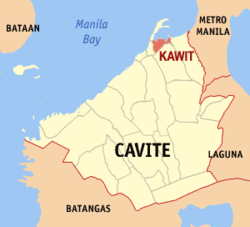Kawit
|
Municipality of Kawit Bayan ng Kawit |
||
| Location of Kawit in the province of Cavite | ||
|---|---|---|

|
||
| Basic data | ||
| Region : | CALABARZON | |
| Province : | Cavite | |
| Barangays : | 23 | |
| District: | 1st District of Cavite | |
| PSGC : | 042111000 | |
| Income class : | 1st income bracket | |
| Households : | 13,510 May 1, 2000 census
|
|
| Population : | 83,466 August 1, 2015 census
|
|
| Population density : | 4998 inhabitants per km² | |
| Area : | 16.70 km² | |
| Coordinates : | 14 ° 29 ′ N , 120 ° 54 ′ E | |
| Postal code : | 4104 | |
| Area code : | +63 46 | |
| Mayor : | Reynaldo B. Aguinaldo | |
| Geographical location in the Philippines | ||
|
|
||
Kawit (officially: Municipality of Kawit ; formerly: Cavite El Viejo ; Filipino : Bayan ng Kawit ) is a Filipino municipality in the province of Cavite .
Kawit is the birthplace of Emilio Aguinaldo , the President of the First Philippine Republic. Kawit is also home to the Aguinaldo Shrine . His cousin was Baldomero Aguinaldo , who was also born in Kawit.
On June 12, 1898 , Aguinaldo proclaimed the independence of the Philippines from Spain in Kawit .
Barangays
Kawit is politically divided into 23 barangays .
|
|
history
The name Kawit is derived from the Tagalog word kawit (English: hook ). The meaning of the name is ambiguous. On the one hand, it points to the location of Kawits at the base of a peninsula with the shape of a hook that protrudes into Manila Bay and lies on Cavite City . Kawit was already a prosperous settlement before the arrival of the Spaniards and, on the other hand, was the first anchorage for the Spaniards in the province of Cavite, from where the missionary work of the entire province began.
According to a legend, the name came about as a result of a misunderstanding. A Spanish visitor asked a local blacksmith about the name of the village. The blacksmith, who was busy forging a piece of metal in the shape of a hook ( kawit ) on his anvil , hesitated to answer because he did not understand what the stranger was asking. However, the blacksmith was pressured to respond. He thought the stranger wanted to know what he was doing and simply replied "kawit". The Spaniard went on, mumbling the word kawit . Over time, kawit evolved into cawite and finally cavite .
For a long time the place was called Cavite el Viejo (Old Cavite) to distinguish Cavite la Punta or Cavite el Puerto , trading port and naval base, (today Cavite City ) . Many Spanish sailors on shore leave came to Cavite el Viejo where a red light district subsequently developed.
The present-day municipalities of Kawit, Cavite la Punta (now Cavite City), Noveleta ( called Tierra Alta by the Spaniards ) and Imus belong to Cavite el Viejo . Gradually, these districts became independent municipalities.
Mayor of Kawit is Reynaldo Aguinaldo, who after three terms as vice mayor ( vice mayor is chosen) on 17 May 2007 in the office of mayor. Reynaldo Aguinaldo is a descendant of Emilio Aguinaldo, the first President of the Philippines.
Web links
- elgu2.ncc.gov.ph - Kawit ( Memento from February 6, 2007 in the Internet Archive )

